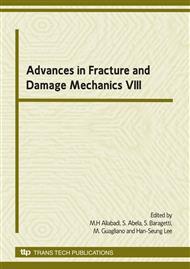p.149
p.153
p.157
p.161
p.165
p.169
p.173
p.177
p.181
Inspection of the Internal Cracks on a Pipe Using a Cylinder-Type Magnetic Camera
Abstract:
Two important factors in damage tolerance engineering are the damage size that can be tolerated and the use of applied nondestructive testing (NDT) technique for detection of defects. Generally, NDT of large mechanical structures, such as vessels and pipes in nuclear power plants, is carried out according to national codes, and the damaged mechanical parts detected during periodic NDT are repaired or replaced after the evaluation. However, unexpected accidents can occur if cracks in the structure grow and exceed the tolerance limit during operation. Therefore, there is a need to develop NDT techniques that can detect micro-damage in the vessels and pipes. In this paper, we propose a cylinder-type magnetic camera to fill this need. We use a cylindrically integrated Hall sensor array (CIHaS) as a magnetic sensor to create magnetic images, and we use a solenoid coil as the source of the magnetic field detected by the magnetic camera in order to achieve high crack-detection ability. The proposed method is tested with an examination of the cracks on a prepared pipe sample.
Info:
Periodical:
Pages:
165-168
Citation:
Online since:
October 2009
Authors:
Keywords:
Price:
Сopyright:
© 2010 Trans Tech Publications Ltd. All Rights Reserved
Share:
Citation:


